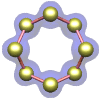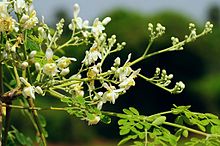![]() http://newdrugapprovals.wordpress.com/2013/06/01/process-for-manufacture-of-telmisartan-patent-us2013137878-a130-may-2013/
http://newdrugapprovals.wordpress.com/2013/06/01/process-for-manufacture-of-telmisartan-patent-us2013137878-a130-may-2013/


Moringa oleifera
The Drumstick Plant
08 February 2013, Organic India, a manufacturer of herb-based functional supplements, has launched organic single ingredient Moringa products in the US.
Available in both capsule and powder formulations, the product made from powdered leaves of Moringa oleifera tree contains vitamin A, B1, B3, B12, iron, magnesium, potassium, amino acids, and polyphenols and is used for restoring internal imbalances.
Organic India national sales manager Heather Henning said the ancient therapeutic Moringa oleifera plant has been used for years and has seen increasing popularity amongst mainstream consumers worldwide.
Moringa oleifera leaf powder
“Millions of people globally use Moringa for essential nutrition — now, the US distribution channel will have access to this extraordinary plant with USDA organic certification,” Henning added.
The company said Moringa supplement, which has more B12 than steak, more vitamin A than eggs, and more calcium than milk, will be unveiled to the public at Expo West 2013.
Sonjna (Moringa oleifera) leaves with flowers
Moringa oleifera (synonym: Moringa pterygosperma) is the most widely cultivated species of the genus Moringa, which is the only genus in the family Moringaceae. English common names include moringa, and drumstick tree, from the appearance of the long, slender, triangular seed pods, horseradish tree, from the taste of the roots which resembles horseradish, or ben oil tree, from the oil derived from the seeds. The tree itself is rather slender, with drooping branches that grow to approximately 10m in height. In cultivation, it is often cut back annually to 1–2 meters and allowed to regrow so the pods and leaves remain within arm’s reach.[1][2]
In developing countries, moringa has potential to improve nutrition, boost food security, foster rural development, and support sustainable landcare.[3] It may be used as forage forlivestock, a micronutrient liquid, a natural anthelmintic and possible adjuvant.[2][4][5]

The moringa tree is grown mainly in semiarid, tropical, and subtropical areas, corresponding in the United States to USDA hardiness zones 9 and 10. While it grows best in dry, sandy soil, it tolerates poor soil, including coastal areas. It is a fast-growing, drought-resistant tree that is native to the southern foothills of the Himalayas in northwestern India.
Cultivation in Hawai’i, for commercial distribution in the United States, is in its early stages.[6]
“India is the largest producer of moringa, with an annual production of 1.1 to 1.3 million tonnes of tender fruits from an area of 380 km². Among the states, Andhra Pradesh leads in both area and production (156.65 km²) followed by Karnataka (102.8 km²) and Tamil Nadu(74.08 km²). In other states, it occupies an area of 46.13 km². Tamil Nadu is the pioneering state in·so·much as it has varied genotypes from diversified geographical areas and introductions from Sri Lanka.”[7]
Moringa is grown in home gardens and as living fences in Tamil Nadu Southern India and Thailand, where it is commonly sold in local markets.[8] In the Philippines, it is commonly grown for its leaves, which are used in soup.[9] Moringa is also actively cultivated by theWorld Vegetable Center in Taiwan, a center for vegetable research with a mission to reduce poverty and malnutrition in developing countries through improved production and consumption of vegetables. Tamil Nadu Southern India has Moringa in its folk stories and as well considered to be auspicious to grow in home. Interestingly the name in Tamil is Moorungai which sounds same as Moringa.
It is also widely cultivated in Africa, Cambodia, Nepal, Indonesia, Malaysia, Mexico, Central and South America, and Sri Lanka
An Indian drumstick (cut)
| Nutritional value per 100 g (3.5 oz) | |
|---|---|
| Energy | 64 kcal (270 kJ) |
| Carbohydrates | 8.28 g |
| – Dietary fiber | 2.0 g |
| Fat | 1.40 g |
| Protein | 9.40 g |
| Water | 78.66 g |
| Vitamin A equiv. | 378 μg (47%) |
| Thiamine (vit. B1) | 0.257 mg (22%) |
| Riboflavin (vit. B2) | 0.660 mg (55%) |
| Niacin (vit. B3) | 2.220 mg (15%) |
| Pantothenic acid (B5) | 0.125 mg (3%) |
| Vitamin B6 | 1.200 mg (92%) |
| Folate (vit. B9) | 40 μg (10%) |
| Vitamin C | 51.7 mg (62%) |
| Calcium | 185 mg (19%) |
| Iron | 4.00 mg (31%) |
| Magnesium | 147 mg (41%) |
| Manganese | 0.36 mg (17%) |
| Phosphorus | 112 mg (16%) |
| Potassium | 337 mg (7%) |
| Sodium | 9 mg (1%) |
| Zinc | 0.6 mg (6%) |
| Percentages are relative to US recommendations for adults. Source: USDA Nutrient Database |
|
| Nutritional value per 100 g (3.5 oz) | |
|---|---|
| Energy | 37 kcal (150 kJ) |
| Carbohydrates | 8.53 g |
| – Dietary fiber | 3.2 g |
| Fat | 0.20 g |
| Protein | 2.10 g |
| Water | 88.20 g |
| Vitamin A equiv. | 4 μg (1%) |
| Thiamine (vit. B1) | 0.0530 mg (5%) |
| Riboflavin (vit. B2) | 0.074 mg (6%) |
| Niacin (vit. B3) | 0.620 mg (4%) |
| Pantothenic acid (B5) | 0.794 mg (16%) |
| Vitamin B6 | 0.120 mg (9%) |
| Folate (vit. B9) | 44 μg (11%) |
| Vitamin C | 141.0 mg (170%) |
| Calcium | 30 mg (3%) |
| Iron | 0.36 mg (3%) |
| Magnesium | 45 mg (13%) |
| Manganese | 0.259 mg (12%) |
| Phosphorus | 50 mg (7%) |
| Potassium | 461 mg (10%) |
| Sodium | 42 mg (3%) |
| Zinc | 0.45 mg (5%) |
| Percentages are relative to US recommendations for adults. Source: USDA Nutrient Database
|
|